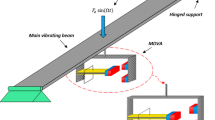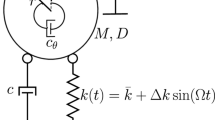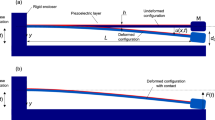Abstract
Background
The nonlinear dynamic behavior of miniature stack-type piezoelectric actuators is not yet fully investigated and is still an open research field.
Objective
The objective of this paper is to determine an accurate dynamical model of an amplified stack-type piezoelectric actuator by using a recently developed nonlinear system identification method, namely Response-Controlled stepped-sine Testing (RCT).
Method
The nonlinear modal identification of a miniature stack-type piezoelectric actuator combined with a rhombus-type compliant mechanism is accomplished by using the RCT method. Several important modifications in the implementation of the RCT method imposed by the miniature nature of the piezo-actuator are successfully achieved for the first time in this study.
Results
Preliminary constant-voltage tests indicate strong softening nonlinearity with jump phenomenon at high voltage levels. In the nonlinear mode of interest, the RCT method quantifies about a 130 Hz change of natural frequency which corresponds to a 3% frequency shift, and a nonlinear modal damping ratio ranging from 1% to 1.5%, corresponding to a 50% change in the amplitude range of interest.
Conclusion
The validity of the single nonlinear mode theory on stack-type piezo-actuators and the quantification of the nonlinear modal damping of this type of actuators are achieved for the first time in this study to the best of the authors’ knowledge. Consequently, an accurate nonlinear modal model is constructed which may help to estimate the parameters of a physical-driven (constitutive) model and therefore gain a better theoretical understanding of the nonlinear behavior of stack-type piezo-actuators. Furthermore, it is shown that the RCT method can be successfully applied for the modal identification of nonlinear miniature electro-mechanical systems.
















Similar content being viewed by others
References
Ouyang PR, Tjiptoprodjo RC, Zhang WJ, Yang GS (2008) Micro-motion devices technology: The state of arts review. Int J Adv Manuf Technol 38(5–6):463–478
Claeyssen F, Ducamp A, Barillot F et al (2008) Stepping piezoelectric actuators based on APAs. Proc Actuator 2008:623–626
Jing Z, Xu M, Wu T, Tian Z (2016) Development of a tilt-positioning mechanism driven by flextensional piezoelectric actuators. Rev Sci Instrum 87:8
Claeyssen F, Letty RL, Barillot F, Sosnicki O (2007) Amplified piezoelectric actuators: Static dynamic applications. Ferroelectrics 351(1):3–14
APA35XS (2014) Cedrat Technologies, [Online]. Available: https://www.cedrat-technologies.com/fileadmin/datasheets/APA35XS.pdf. [Accessed: 09 Oct 2021]
Kumar A, DasGupta A (2018) Dynamics of a shell-type amplified piezoelectric actuator. J Vib Acoust 140(4):1–9
Tiersten HF (2013) Linear piezoelectric plate vibrations- elements of the linear theory of piezoelectricity and the vibrations of piezoelectric plates. Springer
Parashar SK, Von Wagner U (2004) Nonlinear longitudinal vibrations of transversally polarized piezoceramics: Experiments and modeling. Nonlinear Dyn 37:51–73
Shivashankar P, Kandagal SB (2019) Characterization of elastic and electromechanical nonlinearities in piezoceramic plate actuators from vibrations of a piezoelectric-beam. Mech Syst Signal Process 116:624–640
Shivashankar P, Gopalakrishnan S, Kandagal SB (2019) Nonlinear characterization of piezoelectric patches and piezoelectric stacks from vibrations of piezo-actuated structures. Proc SPIE 10967:1–17
Shivashankar P, Gopalakrishnan S, Kandagal SB (2021) Nonlinear modeling of d33-mode piezoelectric actuators using experimental vibration analysis. J Sound Vib 505
Von Wagner U, Hagedorn P (2002) Piezo-beam systems subjected to weak electric field: experiments and modelling of nonlinearities. J Sound Vib 256(5):861–872
Mahmoodi SN, Jalili N (2009) Piezoelectrically actuated microcantilevers: An experimental nonlinear vibration analysis. Sens Actuators A Phys 150(1):131–136
Goldschmidtboeing F, Wischke M, Eichhorn C, Woias P (2009) Nonlinear effects in piezoelectric vibration harvesters with high coupling factors. Proc PowerMEMS 364–367
Stanton SC, Erturk A, Mann BP, Inman DJ (2010) Nonlinear piezoelectricity in electrostatic energy harvesters: modeling and experimental identification. J Appl Phys 108(7)
Stanton SC, Erturk A, Mann BP, Inman DJ (2012) Nonlinear nonconservative behavior and modeling of piezoelectric energy harvesters including proof mass effects. J Intell Mater Syst Struct 23(2):183–199
Leadenham S, Erturk A (2015) Unified nonlinear electroelastic dynamics of a bimorph piezoelectric cantilever for energy harvesting, sensing and actuation. Nonlinear Dyn 79(3):1727–1743
Shahabi P, Ghafarirad H, Tagvaeipour A (2019) Nonlinear vibration analysis of piezoelectric bending actuators: theoretical and experimental studies. Comptes Rendus Mec 347(12):953–966
Karaağaçlı T, Özgüven HN (2021) Experimental modal analysis of nonlinear systems by using response-controlled stepped-sine testing. Mech Syst Signal Process 146
Scheel M, Peter S, Leine RI, Krack M (2018) A phase resonance approach for modal testing of structures with nonlinear dissipation. J Sound Vib 435:56–73
Sherrit S, Trebi-Ollennu A, Bonitz R, Bar-Cohen Y, Yen JT (2010) Compact sensitive piezoelectric mass balance for measurement of unconsolidated materials in space. Sens Smart Struct Technol Civil Mech Aerosp Syst 7647. SPIE
Cabrera MA, Caicedo B, Thorel L (2012) Dynamic actuator for centrifugal modeling of soil-structure interaction. Geotech Test J 35(4)
Yeom T, Simon TW, Zhang M, North MT, Cui T (2012) High frequency, large displacement, and low power consumption piezoelectric translational actuator based on an oval loop sheel. Sens Actuators A Phys 176:99–109
Pages A, Rowe S, Duc S, Sonsnicki O, Jaussaud G, Claeyssen F (2018) Amplified piezo-actuators (APA) enhancement for active vibration control (AVC). ACTUATOR 2018; 16th International Conference on New Actuators, pp. 1–4
Ling M, Zhang X (2021) Coupled dynamic modeling of piezo-actuated compliant mechanisms subjected to external load. Mech Mach Theory 160
Ling M, Yuan L, Luo Z, Huang T, Zhang X (2022) Enhancing dynamic bandwidth of amplified piezoelectric actuators by a hybrid lever and bridge-type compliant mechanism. Actuators 11(5):134
Karaağaçlı T, Özgüven HN (2020) Experimental identification of backbone curves of strongly nonlinear systems by using response-controlled stepped-sine testing (RCT). Vibration 3(3):266–280
Karaağaçlı T, Özgüven HN (2020) A frequency domain nonparametric identification method for nonlinear structures: Describing surface method. Mech Syst Signal Process 144
Damjanovic D (1997) Logarithmic frequency dependence of the piezoelectric effect due to pinning of ferroelectric-ferroelastic domain walls. Phys Rev B 55(2)
Rosenberg RM (1966) On nonlinear vibrations of systems with many degrees of freedom. Adv Appl Mech 9:155–242
Szemplińska-Stupnicka W (1979) The modified single mode method in the investigations of the resonant vibrations of non-linear systems. J Sound Vib 63(4):475–489
Setio S, Setio HD, Jezequel L (1992) A method of non-linear modal identification from frequency response tests. J Sound Vib 158(3):497–515
Gibert C (2003) Fitting measured frequency response using non-linear modes. Mech Syst Signal Process 17(1):211–218
Peeters M, Kerschen G, Golinval JC (2011) Dynamic testing of nonlinear vibrating structures using nonlinear normal modes. J Sound Vib 330(3):486–509
Londoño JM, Neild SA, Cooper JE (2015) Identification of backbone curves of nonlinear systems from resonance decay responses. J Sound Vib 348:224–238
Renson L, Gonzalez-Buelga A, Barton DAW, Neild SA (2016) Robust identification of backbone curves using control-based continuation. J Sound Vib 367:145–158
Peter S, Leine RI (2017) Excitation power quantities in phase resonance testing of nonlinear systems with phase-locked-loop excitation. Mech Syst Signal Process 96:139–158
Krack M (2015) Nonlinear modal analysis of nonconservative systems: extension of the periodic motion concept. Comput Struct 154:59–71
Scheel M, Weigele T, Krack M (2020) Challenging an experimental nonlinear modal analysis method with a new strongly friction-damped structure. J Sound Vib 485
Karaağaçlı T, Özgüven HN (2022) Experimental quantification and validation of modal properties of geometrically nonlinear structures by using response-controlled stepped-sine testing. Exp Mech 62:199–211
Arslan Ö, Özgüven HN (2008) Modal identification of nonlinear structures and the use of modal model in structural dynamic analysis. In Proceedings of the 26th International Modal Analysis Conference (IMAC), Orlando, FL, USA
Link M, Boeswald M, Laborde S, Weiland M, Calvi A (2010) An approach to nonlinear experimental modal analysis. In Proceedings of the 28th International Modal Analysis Conference (IMAC), Jacksonville, FL, USA
Tanrıkulu Ö, Kuran B, Özgüven HN, İmregün M (1993) Forced harmonic response analysis of nonlinear structures. AIAA J 31(7):1313–1320
Krack M (2021) Extension of the single nonlinear mode theory by linear attachments and application to exciter-structure interaction. J Sound Vib 505
Pacini BR, Kuether RJ, Roettgen DR (2022) Shaker-structure modeling and analysis for nonlinear force appropriation testing. Mech Syst Signal Process 162
Renson L, Shaw AD, Barton DAW, Neild SA (2019) Application of control-based continuation to a nonlinear structure with harmonically coupled modes. Mech Syst Signal Process 120:449–464
Abeloos G, Renson L, Collette C, Kerschen G (2021) Stepped and swept control-based continuation using adaptive filtering. Nonlinear Dyn 104:3793–3808
Instruction Manual optoNCDT 2300 (2021) Micro-epsilon messtechnik GbmH & Co. KG [Online]. Available: http://www.micro-epsilon.de/download/manuals/man--optoNCDT-2300--en.pdf. [Accessed: 09 Oct 2021]
Acknowledgements
This research was funded by ASELSAN Inc. The financial support is gratefully acknowledged.
Author information
Authors and Affiliations
Corresponding author
Ethics declarations
Conflict of Interest
The authors declare that they have no conflict of interest.
Additional information
Publisher's Note
Springer Nature remains neutral with regard to jurisdictional claims in published maps and institutional affiliations.
Rights and permissions
Springer Nature or its licensor holds exclusive rights to this article under a publishing agreement with the author(s) or other rightsholder(s); author self-archiving of the accepted manuscript version of this article is solely governed by the terms of such publishing agreement and applicable law.
About this article
Cite this article
Koyuncu, A., Karaağaçlı, T., Şahin, M. et al. Experimental Modal Analysis of Nonlinear Amplified Piezoelectric Actuators by Using Response-Controlled Stepped-Sine Testing. Exp Mech 62, 1579–1594 (2022). https://doi.org/10.1007/s11340-022-00878-y
Received:
Accepted:
Published:
Issue Date:
DOI: https://doi.org/10.1007/s11340-022-00878-y




